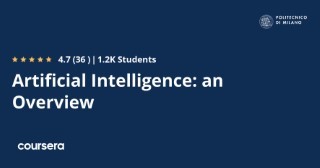Artificial Intelligence (AI) Education for Teachers
Discover the importance of artificial intelligence (AI) in education and how it can be integrated into the curriculum. Enhance your understanding of AI and its applications with this comprehensive course designed for teachers. Learn essential skills and values beyond coding and technology to prepare students for the future. Join Macquarie School of Education and IBM Australia in this aligned professional learning course, offering a unique Capstone Project opportunity. Start your journey towards AI proficiency and equip yourself with the knowledge and tools to empower your students in the 21st century.
Today’s learners need to know what artificial intelligence (AI) is, how it works, how to use it in their everyday lives, and how it could potentially be used in their future. Using AI requires skills and values which extend far beyond simply having knowledge about coding and technology.
This course is designed by teachers, for teachers, and will bridge the gap between commonly held beliefs about AI, and what it really is. AI can be embedded into all areas of the school curriculum and this course will show you how.
This course will appeal to teachers who want to increase their general understanding of AI, including why it is important for learners; and/or to those who want to embed AI into their teaching practice and their students’ learning. There is also a unique opportunity to implement a Capstone Project for students alongside this professional learning course.
Macquarie School of Education at Macquarie University and IBM Australia have collaborated to create this course which is aligned to AITSL ‘Proficient Level’ Australian Professional Standards at AQF Level 8.
What you will learn
Introduction
In this module we’ll introduce you to the course, tell you a little bit about why we think it’s important that you and your students know about artificial intelligence (AI), and share with you some additional resources that might be useful.
Knowledge Module: What is AI, History of AI, and Applications of AI
In his book, “Make. Think. Imagine”, John Browne writes: “Artificial intelligence seems to be everywhere”. Some of its recent applications and achievements are well known; its potential to help build – or undermine – our civilisation is immense. As teachers, it’s hard for us to ignore this potential. AI is changing the tools we have at our disposal and adds to the impetus for a curriculum which incorporates the so-called “21st century skills”. In this module, you will think about how AI may be defined, particularly in relation to human intelligence, and how it has taken different forms. You will consider how it has evolved over the last 70 years and come to show promise in so many different applications.
Skills Module – Part A: Design Thinking, and Critical and Creative Thinking
Both design thinking, and critical and creative thinking (CCT), embrace skills which are important for teams working to solve problems with AI. In design thinking, these skills include collaboration, solving a problem with constraints, coming up with an idea, testing it, and if necessary, going back to the drawing board. The process is iterative. As for CCT, creative thinking is required to identify opportunities for AI, and critical thinking can help us evaluate its application. In this module, you will learn about the key principles and stages in the design thinking process. You will consider CCT from the perspective of convergent and divergent thinking, de Bono’s Six Hats, and ACARA’s four quadrant model. Examples of “creative AI” will be examined to help us understand the barriers to machine creativity.
Skills Module — Part B: Data Fluency, and Computational Thinking
When it comes to computational thinking skills, there are two people who’ve been very influential in bringing them to the classroom. One is Seymour Papert who in the 1960s developed a computer program for children. The other influential person is Jeanette Wing, a data scientist, who wrote a short article advocating the use of computational thinking. In this module, you’ll appreciate that human or AI decision-making depends crucially on the quality of data. You’ll think about what data is, how it takes different forms and can be represented in different ways. Using the website, Machine Learning for Kids, we will look at what has been a classic problem in image recognition: being able to distinguish between cats and dogs. You’ll also learn about just what computational thinking is, its place in the Australian Curriculum, and the ideas and skills behind it. You’ll see how these skills can be developed with both “unplugged” and computer-based activities.
User Reviews
Be the first to review “Artificial Intelligence (AI) Education for Teachers”
You must be logged in to post a review.







There are no reviews yet.